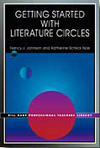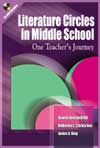In
literature circles, small groups of students gather together to
discuss a piece of literature in depth. Getting Started
with Literature Circles is a handbook for teachers who are just
beginning to use this approach in their elementary or middle school
classrooms. The book is based on our work with teachers in grades
1 - 6 during their first year using literature circles.
The book is organized into eight chapters,
each with a specific focus on one of the key components of literature
circles: goals, classroom climate, structure, selecting books,
discussions, response journals, focus lessons, and extension projects.
Woven into each chapter are the experiences of classroom teachers,
numerous examples from students, and strategies for assessment and
student self-reflection. Each chapter concludes with "What
is worth worrying about and what is worth letting go?" and answers
to some common questions about literature circles.
Why
did you write the book . . .?
We wrote this book as a companion to Literature Circles and Response,
which we co-edited with Bonnie Campbell Hill. Some teachers
will find that this book serves well as a "prequel" to LC&R.
Others who have already read and used LC&R may turn to
this book for concrete guidance as they make decisions about the
components of literature circles.
While "getting started" books can often
be prescriptive, the goal of Getting Started is to be descriptive,
offering a range of possibilities. This book will serve
as a handbook, addressing key components to beginning literature
circles, as well as offering specific classroom examples and answering
questions raised by teachers. As such, it does not assume
that readers have in-depth experience already. We want the
book to mentor teachers while honoring each readerís specific setting,
students, experience, needs, and style.
The major audience for this book is classroom
teachers in grades 1 through 6, teacher educators, curriculum directors,
librarians, and administrators who see themselves as instructional
leaders. Primarily, we expect that this book will be used
by teachers and student teachers in their classrooms, teacher educators
in methods courses, curriculum specialists in staff development
programs, and librarians who are looking for innovative practices
for the library.
Outstanding
Features:
Handbook
Format
Each chapter stands alone, offering specific
ideas that teachers can try immediately and then adapt with experience.
The format invites teachers to "dip" into a specific chapter; they
do not have to read the entire book in order to begin
Perspective
The book balances the "how to" of literature
circles with the larger issue of philosophy, goals, and expectations.
The book begins with creating a classroom climate for respect and
collaboration, considering where literature circles fit within a
balanced literacy program, articulating specific expectations for
what students will gain from literature circles, and considering
literature circles' benefits. The chapters that
follow include classroom examples and structural components set
within this philosophical framework.
Classroom
Examples
We present a variety of possibilities for structuring
and managing literature circles. The book shows alternatives
that feature different teachers' experiences. The book prompts
readers to consider commonalties, as well as adaptive possibilities.
It does this through forms and classroom examples, as well as teachers'
voices explaining how and why these components work. All of
examples come directly from teachers who have recent experience
with beginning literature circles. The book presents strategies
specific to its audience.
Incorporating
Literacy Skills and Strategies
The book includes discussion of how to weave
in literacy skills and strategies as an integral part of literature
circles. The book offers focused teaching suggestions based
on what students demonstrate they need as readers and writers.
Whatís
Worth Worrying About?Whatís Worth Letting Go?
Each chapter acknowledges the pressures teachers
feel when they incorporate literature circles into their already
full curriculum by including brief suggestions of what to focus
on ("Whatís worth worrying about?") and what to set aside ("Whatís
worth letting go?").
Frequently
Asked Questions
Each chapter contains a section answering common
and recurring questions teachers ask about literature circle components.
The answers represent different teachers' approaches and thinking.
Book
List
Sample book lists organized by topic, theme,
and genre are included in the chapter on how to select appropriate
books for literature circles. This selection includes
teacher recommendations of books that work well for initial literature
circles. The chapter also teacher resources for book
selection: journals, professional books, and web sites and
computer resources.
Courses
in which this book will most likely be used
This book can be used effectively in the following types of college
or university courses: Literacy methods for preservice teachers
and graduate students, childrenís and young adult literature courses,
courses for librarians and library media specialists, and courses
on reader response.
The book will also serve professional development courses
and workshops for inservice teachers. |

